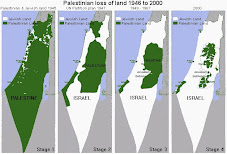 Photo: Suhair Karam/IRIN  |
| Some Gazans are using mud bricks to build houses |
Eighteen months after Israel’s 23-day offensive in the Gaza Strip, three-quarters of damaged homes, buildings and infrastructure remain unrepaired, according to a reconstruction needs assessment published by the UN Development Programme (UNDP) in Jerusalem.
Around US$527 million is required to return Gaza to its pre-war state (in December 2008), UNDP said, adding that the figure was just a fraction of what was needed to repair and reverse the degradation of public and private infrastructure during the four-year Israeli blockade.
The assessment said most health facilities had been repaired, along with about 78 percent of public water and sanitation facilities. However, only half the damage to the electricity network, and almost none of the transport infrastructure, had been fixed.
The International Committee of the Red Cross (ICRC) says the critical issue facing Gaza’s medical facilities is the lack of medicines, medical equipment and an acute electricity crisis. “The power supply in Gaza is interrupted for seven hours a day on average. The consequences for public services, especially the primary health-care system, are devastating,” it said in a 14 June statement, adding that hospital fuel reserves for generators kept drying up.
The UNDP assessment said the major obstacle to recovery from the war is the blockade, which only allows imports of goods which Israel deems humanitarian. The blockade severely restricts the entry of essential building materials such as cement, iron and glass, rendering mostly ineffective efforts by the international community to rebuild.
“The UN position is clear. We expect the blockade to be lifted for a restoration of basic rights for the Gaza population,” John Ging, head of the UN agency for Palestinian refugees (UNRWA) in Gaza, told IRIN. “This political will to end the blockade must be mobilized and turned into action, exploring every option for practical solutions, including opening the Gaza seaport.”
Israeli change of policy
On 27 June - following, but not necessarily as a result of, lethal Israeli military action against an aid-carrying flotilla manned by activists - Israel agreed to allow a greater number of goods into Gaza: It will enable and expand the inflow of construction materials for approved Palestinian Authority-authorized projects under international supervision....
However, it said the current security regime for Gaza would not be changed - because of Hamas rule....
“We have not seen a list [of items prohibited from entering Gaza] yet, but we need a complete change of approach since the list of about 114 items allowed to enter was inappropriate,” said UNRWA’s Ging.
UNRWA, UNDP efforts
About 400 trucks of construction materials have entered Gaza over the past four months, allowing UNRWA to complete the construction of a water treatment plant in Rafah and finish about 150 housing units that were already 80 percent complete, according to Ging.
He said UNRWA had secured $460 million to rebuild the homes of 2,300 refugees, 100 schools and a teacher training college, assuming the materials would be delivered.
There are about one million Palestinian refugees and about half a million non-refugees living in Gaza.
 Photo: Free Gaza  |
| Gazans salvage what they can from the rubble of their homes |
Some 217 schools and 60 kindergartens were damaged or destroyed during the Israeli offensive, according to UNDP.
UNDP has secured $200 million to rebuild 1,200 houses for non-refugees, but has been unable to get the building materials in, said Amran al-Kharouby, a UNDP project manager in Gaza.
“Cheap cement and steel are entering Gaza via underground tunnels along the Gaza-Egypt border, but UNDP cannot work with it,” he said.
However, UNDP said small-scale Gazan industries using crushed rubble from destroyed buildings have repaired some 25 percent of the infrastructure damage inflicted by Israel during their military operation, which destroyed or damaged at least 6,268 homes as well hundreds of public buildings.
“Building materials like cement exist in Gaza from the tunnels, but we lack the money to purchase them,” said Ansar Abu Amra, a 52-year-old refugee whose family home worth $50,000 was levelled during the offensive. The 10-room home stood next to the Ministry of Planning, which was targeted. “UNRWA promised to pay $6,000 but so far I have received nothing,” he said.
Hamas efforts
Public buildings will be rebuilt by the Hamas-led government, but construction has yet to begin, according to Yasser Shunt, a senior engineer at the ministry of housing and public works in Gaza.
 Photo: Erica Silverman/IRIN  |
| More good are getting into Gaza, but not enough the UN says |
He said the government had so far spent about $500,000 on reconstruction efforts, including the repair of about 700 houses using some materials that came from Israel and through projects funded by international organizations such as Turkish NGO Foundation for Human Rights and Freedoms and Humanitarian Relief (IHH - considered a “terrorist” body by the Israeli government) and Gaza-based NGOs such as Dar al-Kitab al-Suna and al-Rahma Alamia.
Seventeen schools have been repaired by the education ministry in Gaza with funding from international donors, such as the British consulate in Jerusalem, with another 16 scheduled for repairs, said Jamal Abdel Bari, head of the education ministry’s construction department.







